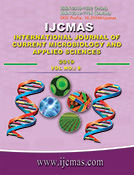


 National Academy of Agricultural Sciences (NAAS)
National Academy of Agricultural Sciences (NAAS)

|
PRINT ISSN : 2319-7692
Online ISSN : 2319-7706 Issues : 12 per year Publisher : Excellent Publishers Email : editorijcmas@gmail.com / submit@ijcmas.com Editor-in-chief: Dr.M.Prakash Index Copernicus ICV 2018: 95.39 NAAS RATING 2020: 5.38 |
In the current investigation, the anti-biofilm potential of Argemone mexicana and Calotropis gigantea against 11 clinical isolates viz Escherichia coli, Pseudomonas aeruginosa, Enterococcus, Enterobacter aerogenes, Klebsiella pneumoniae, Staphylococcus aureus, Proteus vulgaris, Proteus mirabilis, Citrobacter, Serratia marcescens and Staphylococcus epidermidis were tested. The phytochemicals extracted in different solvents were analysed for their antibiofilm ability. For detection of biofilm formation, 11 clinical isolates were screened by Tube method (TM), Congo red agar (CRA), Static Glass coupon reactor method and invitro catheter method. Of the 11isolates, 7(57.8%) displayed a biofilm-positive phenotype under the optimized conditions in the TCP method and strains were further classified as strong 3 (27.27 %) and moderate 4 (36.36 %) while in 4 (36.36 %) isolates weak or no biofilm was detected. Though TM correlated well with the CRA test for 3 (27.3 %) strongly biofilm producing strains, weak producers were difficult to discriminate from biofilm negative isolates. Screening on Static Glass coupon reactor does not correlate well with either of the two methods for detecting biofilm formation in clinical isolates. Methanolic extract of Argemone mexicana consistently showed inhibitory effect against the E. coli, P. vulgaris and P. aeruginosa, while acetone extract of Argemone mexicana showed inhibitory effect against S. aureus and Enterococcus. Calotropis gigantea however was less efficient when compared to Argemone mexicana.
 |
 |
 |
 |
 |